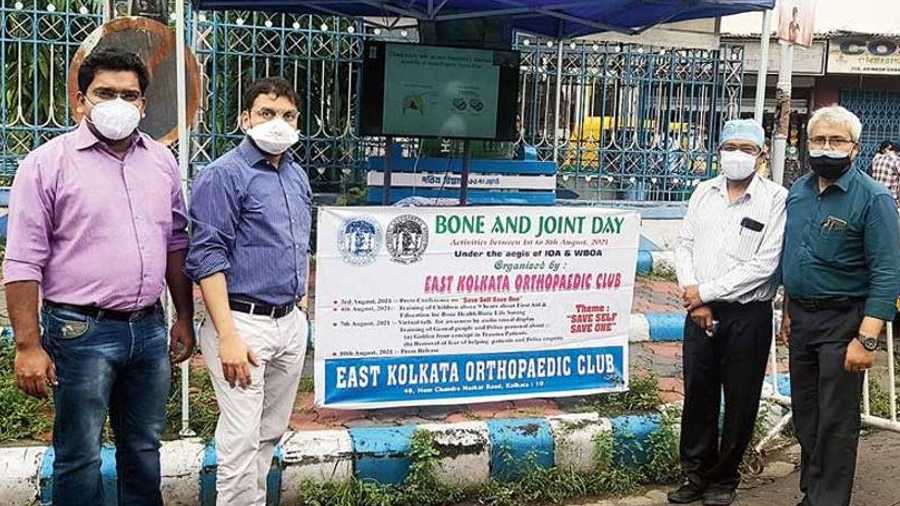Lockdowns and restrictions may have reduced traffic, but our roads are not necessarily safer. “Many bus and train commuters are now cycling to work and the changed dynamics on the streets may in fact increase road accidents. In such an event, we need to ensure passersby can provide first aid to victims before an ambulance arrives,” said Shamik Hait, consultant orthopaedic surgeon and joint secretary of East Kolkata Orthopaedic Club.
August 1 to 8 was celebrated as Bone and Joint Week and the club observed it by hosting a series of promotional activities online and at busy junctions across east Kolkata. “Orthopaedics have a huge role to play in the case of road accidents as most such cases result in broken bones and joints. And it’s terrible when we get a patient who dies, not of the injury sustained in the accident but, because of the incorrect way he was lifted and brought to the hospital by well-meaning passersby,” added joint secretary and orthopedic surgeon Soham Mandal.
Not only do people not know how to help victims but they are also scared of police harassment and so simply turn away from such cases, added secretary of the club, orthopedic surgeon Debasis Datta. “The theme this year is ‘Save Self Safe One’ and we held camps with students, teachers, police etc through the week. Ten-year-olds can learn this and once the Covid situation improves we want to hold more such camps.”
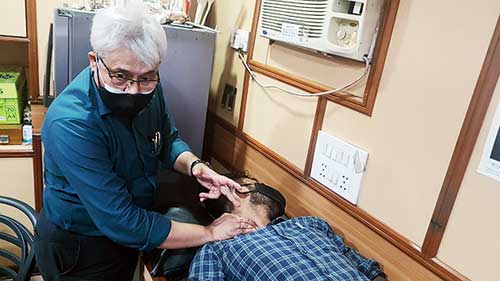
Dr Debasis Datta teaches how to check carotene pulse and (below) how to hold a victim so he can breathe easily
Golden hour
Orthopedic surgeon Ananda Kisor Pal, who conducted a webinar on the subject, began with some sad statistics. “A quarter of worldwide deaths are caused by accidents. In the under 40-age group, it is the number one cause of death. After a critical injury, the victim’s life hangs in balance and his treatment has to start within 60 minutes. This is the golden hour period beyond which he may lose his life or be permanently disabled,” said Pal, who is also a professor of orthopedics at IPGME&R SSKM Hospital.
The surgeon urged people to help victims in such cases without worrying about police harassment. “In developed countries such training forms part of primary education. Yes, India lacks such infrastructure but even more than that, it lacks humanity. People here do not come forward to help strangers,” he said.
Here are some pointers from the session —
Before the rescue
• The first 10 minutes after an accident are platinum minutes. Every move you make in this time must be to save life and limb. Maintain your presence of mind and be proactive.
• Proceed only if the environment is safe. Do not try to rescue another if there is the threat of fire, water, dangerous slope, unstable structures around or hostile bystanders. You do not want to increase the victim toll by becoming one yourself.
• Do not go in without at least a mask. Even better if you have gloves, a face shield, gown and eye protection but a mask is the most important. While these are quite handy in Covid times, this advice is not restricted to Covid times. Sometimes the victim can vomit or sneeze on you and spread infectious diseases. In case he is bleeding and you happen to have a cut too, blood-to-blood diseases can spread.
• If there is no one to help you, go ahead alone. But the ideal number of rescuers for a victim is three. Ask two friends or bystanders to help you. Of course, if it’s a bus accident with 20 victims you will need many more helpers.
• Determine the nature of injury. Was it a pedestrian hit by a car or a passenger hit by a truck? Or is the victim bent double with a stab wound? The nature of the injury will determine your course of action (see right for details).
• Once you know what has happened to the victim, call the appropriate department for help — ambulance, police, fire brigade, electrical workers…. The government has plans of setting up trauma ambulances at busy junctions of the city. Anyone in need could dial the police helpline and have the nearest ambulance reach them in minutes. Such vehicles would be equipped with life saving gadgets.
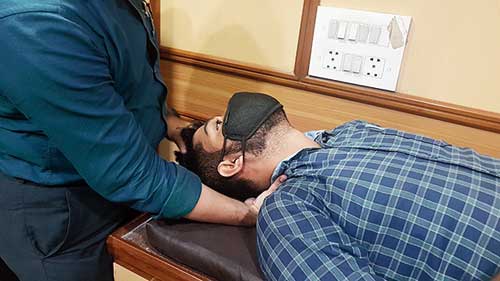
Turn a victim over if he is lying face down with three or four people each turning a part of the body
Three questions
If the victim is conscious, ask him three questions at once-
1. What happened?
This will tell you the nature and severity of the accident.
2. Where are you hurt?
This will tell you which part of his body needs attention. For instance, if his hand is bleeding, apply pressure on it with a dupatta or handkerchief. If it is in pain, you can make a splintage to immobilise it and prevent further injury.
3. What is your name?
This will tell you his orientation. If he is speaking coherently you can rule out brain injury. Also, listen closely to how he speaks. Is his speech clear or are his words muffled? If they are, his airway could be blocked with vomit or broken teeth and he may be having difficulty breathing. Do not offer drinking water to such a victim as it may further obstruct his airway (more on this below).
Unconscious victim
If the victim seems to lie lifelessly and does not respond to being called or shaken, try the “sternum rub”. For this, fist your palm and with the knuckles rub the victim’s chest hard. This is an extremely painful stimulus and if the victim is even in a semi-conscious state, he shall react.
If he does not come about, you need to ensure his airway is clear (more on this below) so he can breathe.
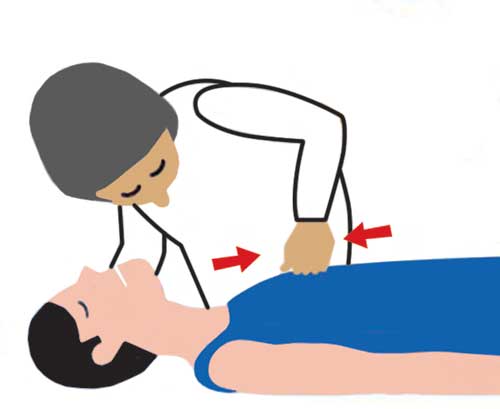
Check vitals
Next you need you check different functions of his body. These have been abbreviated alphabetically from A to E so you can recall them easily at a time of crisis-
A. Airway- The airway is the windpipe in the throat that allows air to enter and leave the lungs. If the victim’s airway is blocked and oxygen supply to his brain is stopped for five to 10 minutes, he could die.
To check if his airway is clear, see if his chest is moving up and down while breathing. Keep your hand near his nostrils to feel him exhaling air. Also, listen to him breathing. Is it soundless as it should be or is it noisy? The latter means there is some obstruction. As mentioned earlier, this could be vomit that he is choking on or the impact of the accident may have broken his teeth and sent them into the pipe etc.
Such a victim needs to be lain down in a way that allows him to breathe easily. Often the victim’s head may be bent inwards to his chest or to a side. Such a bend is detrimental. Lay him down and keep a folded towel or dupatta under his neck and head such that the neck is straight and his chin is up. If you find no towel or dupatta keep your forearm under his neck to give his neck the lift. Hold his head in the position till the ambulance arrives (in picture above right).
If the victim has fainted, you have another potential problem at hand. In an unconscious person, the tongue tends to fall backwards inside the mouth, thereby blocking the airway. This can cut his oxygen supply and kill him. To prevent this, place your hand or the dupatta under the person’s neck as explained above.
B. Breathing- Normally, a person breathes 16 to 18 times a minute. It is worrisome if this reduces to less than eight or increases to more than 40. If it falls under eight, mouth-to-mouth resuscitation is recommended but again, not in Covid times.
C. Circulation- The pulse is your heart rate, or the number of times your heart beats in one minute. It’s bad news if the pulse falls under 60, rises over 120 or is absent altogether.
To check the victim’s pulse, face his palm upwards and place two of your fingers on his wrist, on the side of the thumb. The throbbing you feel his ‘radial pulse’. If you cannot read the radial pulse, you have to try for “carotene pulse”.
Sometimes after an accident, the body goes into shock. In such cases, the heart prioritises pumping blood to the brain over the wrist or anywhere else in the body. This is what carotene pulse measures. For this, place two fingers on the victim’s neck, slightly to right or left of the centre. If you get a pulse here it means blood is still being pumped to the victim’s brain (in picture top).
D. Disability - if the victim’s hand or leg is hurt you have to ensure minimum movement there while he is being transported to the hospital. Gather jugaad items and make a splintage if need be. Splintage is contraption used to immobilise an injured body part to prevent causing further damage. For instance, if his leg needs to be kept straight, use a dupatta and tie it with an umbrella, rolled-up newspaper, cushion or even his other leg.
E. Exposure - If the victim’s T-shirt seems wet, you need to know why. Is it water or blood? A person has five to six litres of blood in his body and if he loses 1 to 1.5l, he may die. Cut his T-shirt off to expose the injured part. Do not try to remove it from his head as the jerking may cause further pain and damage. Get something sharp and cut the cloth apart.Once you identify the source of blood, compress it. Tie it with a cloth or dupatta. The pressure should stop the bleeding.
Keep in mind
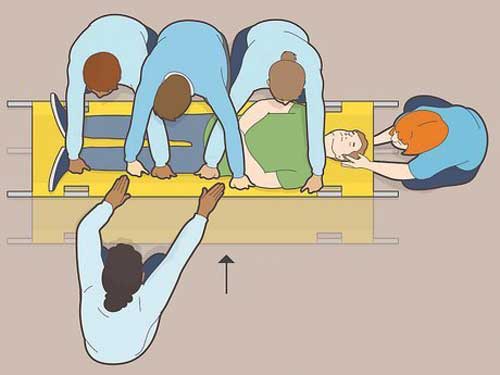
• If the victim is lying face down, do not turn him over casually by his shoulder. You need three to four people for this task — one to hold his head, a second to hold his feet, and one or two more people to hold his body. The “leader” should hold the head and the group must roll him over together from all sides the way they would a piece of log. This is called the “log roll technique” and minimises movement of the victim’s spine (graphic above). Spinal injuries are common in road accidents and such log rolls will prevents twisting of the spine.
• If it’s a bike accident, the helmet needs to be removed from the victim’s head. The helmet may have saved his head but his spine is still exposed. The shape of the helmet is such that it bulges on the back and when the victim is lying down, the neck is forced into an unnatural position. It is not aligned with the head and spine and will worsen his injury. You have to remove the helmet but this should never be done alone. One person needs to hold the victim’s neck and shoulders steadily while another pulls out the helmet off gently.
• If a foreign object has got
inserted into the victim’s body, never try to pull it out yourself. It is sure to cause more damage. Leave it as it is, minimise movement and wait for a doctor.
• If a part of the victim’s body, such as his finger, gets cut off, it can be attached to the body again provided you reach the doctor in six hours. But care has to be taken. Keep the body part in a clean plastic bag and tie it such that it becomes water-tight. Now place this bag in another larger bag that is filled with ice water. Rush to the hospital with it.
